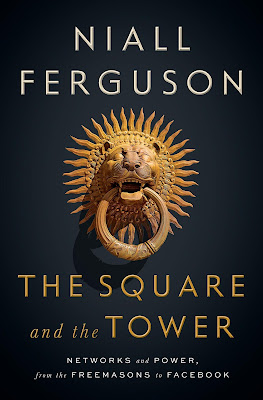 Here are a few excerpts from a book I recently read, "The Square and the Tower: Networks and Power, from the Freemasons to Facebook," by Niall Ferguson:
Here are a few excerpts from a book I recently read, "The Square and the Tower: Networks and Power, from the Freemasons to Facebook," by Niall Ferguson:Even today, the majority of academic historians tend to study the kinds of institution that create and preserve archives, as if those that do not leave an orderly paper trail simply do not count. Again, my research and my experience have taught me to beware the tyranny of the archives. Often the biggest changes in history are the achievements of thinly documented, informally organized groups of people.
From the early 1500s, this world of hierarchy came under a dual assault from revolutionary networks. Harnessing their superior navigational technology and seeking new commercial opportunities, ‘discoverers’ and ‘conquerors’ from Western Europe sailed to other continents in increasing numbers, toppling – with the assistance of the pathogens that accompanied them – all the established rulers of the Americas and establishing a global network of fortified entrepôts that more slowly gnawed away at the sovereignty of Asian and African polities. At the same time, disseminated through the printing press as well as from pulpits, a religious virus that came to be known as Protestantism disrupted an ecclesiastical hierarchy that could trace its lineage back to St Peter. The consequences of the Reformation were at first felt in Europe, and they were terrible indeed.
Poverty alone is seldom enough to drive mass emigrations. What is needed is political upheaval at home and the prospect of a more stable habitat within affordable reach. The period between around 1840 and 1940 presented roughly 150 million people living at the two extremities of the Eurasian landmass – Europe and China – with both. Revolutions, wars and the attendant miseries coincided with a steep decline in transport costs. The result was an exodus – or, to be precise, three exoduses, each of comparable magnitudes. The well-known mass migration (55–8 million people) was from Europe to the Americas, principally to the United States. The less familiar were the great outflows of Chinese and Indians to south-east Asia, the Indian Ocean rim and Australasia (48–52 million), and of Russians and others to Manchuria, Siberia and Central Asia (46–51 million). One historical puzzle is why there was not a larger flow of Chinese to the United States. Though the Pacific Ocean is much wider than the Atlantic, the passage from Shanghai to San Francisco was not impossibly expensive, and the economic opportunities in booming California were numerous and financially enticing. There was nothing to stop Chinese migrant clusters performing the same role as Irish and Italian clusters on the East Coast, attracting more and more people to cross the sea to the promised land. The answer to the puzzle is politics. For had it not been for a populist backlash against Chinese immigration to the United States, the flow across the Pacific would surely have been larger – and the Chinese-American population today commensurately larger, too.
The lesson of this episode is very clear. Just as global networks of communication and transportation had made the mass migrations of the late nineteenth century possible, so political networks of populism and nativism sprang into life to resist them.


No comments:
Post a Comment